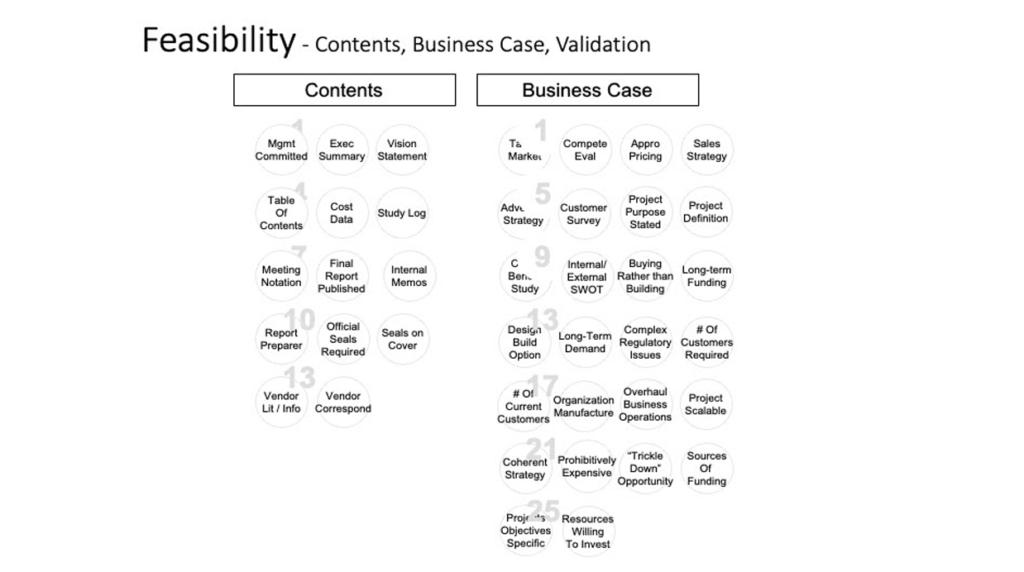
1 – Does Management have a strong commitment to this idea?
2 – Does the feasibility study have an executive summary? Is it in the front of the report?
3 – Is the firm’s vision statement either included or referred to in the feasibility study?
4 – Does the feasibility study have a table of contents?
5 – Is cost data included in the feasibility study?
6 – Is there a feasibility study log that identifies the effort (people, time, cost, resources such as testing) it took to create the study’s details?
7 – Are meetings documented?
8 – Has a final report been published?
9 – Are internal memorandums related to this idea included or accessible?
10 – Is the name of the person who prepared the study included on the study’s front cover?
11 – Are official seals (such as Professional Engineer license stamps) required?
12 – (If applicable) Are the required official seals included on the study’s front cover?
13 – Is vendor literature related to this idea included?
14 – Is a copy of all correspondence with relevant vendors included in the study?
————————————————
BUSINESS CASE:
1 – Has the target market for this idea been established?
2 – Has the firm evaluated the competition and its offerings?
3 – Is the firm’s proposed idea priced appropriately?
4 – Has the firm established an effective sales strategy to support the proposed idea?
5 – Has the firm determined an appropriate advertising strategy for this idea?
6 – Has the firm consulted directly with external customers that it thinks will buy the idea?
7 – Is the idea’s purpose clearly stated?
8 – Has the idea been condensed to a project definition statement?
9 – Has a cost/ benefit study been performed?
10 – Has the firm performed a SWOT (Strength, Weakness, Opportunities, Threats) analysis on itself? On its competition?
11 – Has senior management/ project management/ team considered buying rather than building products/ services?
12 – Does project have a predictable long-term funding plan? (No = bad)
13 – (For large projects) Has the design-build project option been considered? (No = blue)
14 – Will there be sufficient long-term demand for the project being proposed? (Yes = good)
15 – Are there any complex regulatory issues that must be addressed? (Yes = blue)
16 – Does SM/ PM know the number of customers required to make the product/ service break even? (No = blue)
17 – Does the SM/ PM know the number of customers/ potential customers it currently has? (No = blue)
18 – Does the organization have the ability to manufacture and market the end product? (No = blue)
19– Will this project’s roll-out require a significant overhaul of business operations? (Yes = good)
20 – Is this project (product/ service) scalable (e.g., manufacturable)? (No = blue)
21 – Has SM developed a coherent strategy and that is well thought out and easily explained and provable/ proven to customers/ stakeholders? (No = bad)
22 – Will this new product be so prohibitively expensive that it is not commercially viable? (Yes = bad)
23 – Is there any potential “trickle down” opportunity – should this project be completed? (Yes = good)
24 – Does SM/ PM know the sources of funding that is/ is not available to the project? (Yes = good)
25 – Are the project’s objectives specific and limited? (Yes = good)
26 – Has senior management committed to the amount of resources they are willing to invest and possibly lose entirely (walk away decision)?
